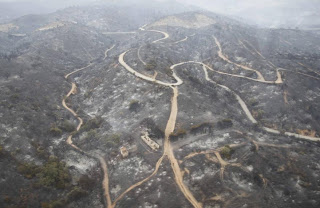Marbella - A Disappointing Experience
It had been over a decade since I last visited Marbella and my memory of the town was hazy to say the least.
I could have saved myself the bus fare and let it remain a soft-focused snap from my mental travel album.
I could have saved myself the bus fare and let it remain a soft-focused snap from my mental travel album.
Only the day before, the biggest fire in Andalucía for twenty years had been extinguished after it had spread throughout the campo (countryside) from Fuengirola to Marbella and inland to Ojén, Monda and Coín. The hillsides to the north of the dual carriageway were blackened from the ravages of the fire whilst in stark contrast the firebreaks and country tracks were highlighted a dusty ochre, a sombre setting as we motored towards Marbella.
 |
| Courtesy of http://www.diariosur.es/multimedia/fotos/ultimos/105317-imagenes-incendio-declarado-coin-0.html |
We left the bus on Marbella’s main street, Avenida Ramon y Cajal, and walked up San Lazaro into the Old Town. A jumble of narrow streets that open into small plazas, the Old Town tries to retain some of its charm whilst the rest of Marbella is taken over by high rise hotels, shops and bars. It is a battle that it is barely winning. The Plaza de la Victoria is a shaded plaza with a fountain and only a few cafès jostling for the attention of the tourist crowd but a short walk along Estacion and the Plaza de los Naranjos is a different story. A rectangular plaza it takes its name from the orange trees that grow in the centre of the plaza and offer respite from the Mediterranean sun. Sadly, unless you are willing to pay inflated prices for a cup of coffee or standard fare you cannot take advantage of the trees – the centre is scarred with tables that spill out from the restaurants and bars that hog three sides of the plaza. The architecture is hidden behind parasols, boards advertising food and platoons of waiters. In its current form it was not a place I wished to linger in.
 |
| THE free seat in the Plaza de los Naranjos |
Heading round to the Plaza Iglesia we passed shops selling Italian linen and a busker playing a Hang drum, not the most Andalucían experience imaginable. The Plaza Iglesia is an uninspiring plaza with only the church on one side and the remains of the castle wall on the other to recommend it. The church did not have any particular iconography or stylistic architecture to place it above any other. From the church, up a staircase and we were headed to the remains of the town’s castle. I should have done my homework because disappointment followed disappointment as I discovered that the castle remains were purely the walls and there was nothing to explore within.
 |
| Castle Walls |
We wandered through the smaller winding streets of the town where some of the Andalucían charm became more evident with bougainvillea cascading down walls and old ladies sitting in the shade by their open windows whilst the men sat on benches below discussing the tribulations and joys of living in modern Spain. A hot chocolate in El Reloj gave me sufficient impetus to walk along Ancha to the Plaza San Cristobel past small side streets and old buildings in various states of disrepair that have a quaintness to them that can allow you to forget the commercial bustle that fills Marbella.

The Plaza San Cristobel, with its small chapel which is viewable through iron grates but only open for the celebration of Mass, is a three-sided affair with a small fountain within which we saw a man shuffling around looking for coins. A sign of the economic crisis that Spain is facing, or an old habit? He was watched silently from the side-lines by an aged man on a bench and an old lady who sat Miss Haversham like behind her shrouded window.
We wound our way back through the town towards the sea as the tables in the Plaza de los Naranjos filled with those willing to shell out a small fortune for their food. Through the small park where shaded benches were occupied predominantly by men reading books or watching the world pass them by we arrived at the top of the Avenida del Mar. Along its length, which ends with the Playa de la Venus (Venus Beach), are sculptures by Salvador Dali which provide a wonderfully surreal and interesting walk. Comparing the sculpture of the elephant on the beach with Dali’s ‘elefante cosmico’ (which is referred to as a rhinoceros in many write-ups and you can see why, particularly knowing Dali’s penchant for rhinceros horn shapes in his work)is one way to pass a few minutes.
 |
| Avenida del Mar |

If the mood had taken us we could have strolled along the Golden Mile to Puerto Banus to gaze at the yachts of the wealthy if not famous and stare into the windows of the boutiques that fill the narrow streets behind the port. However, the plethora of high rise hotels was off-putting and with almost miraculously good timing we boarded the bus and headed back towards another tourist resort – Fuengirola.







Comments
Post a Comment